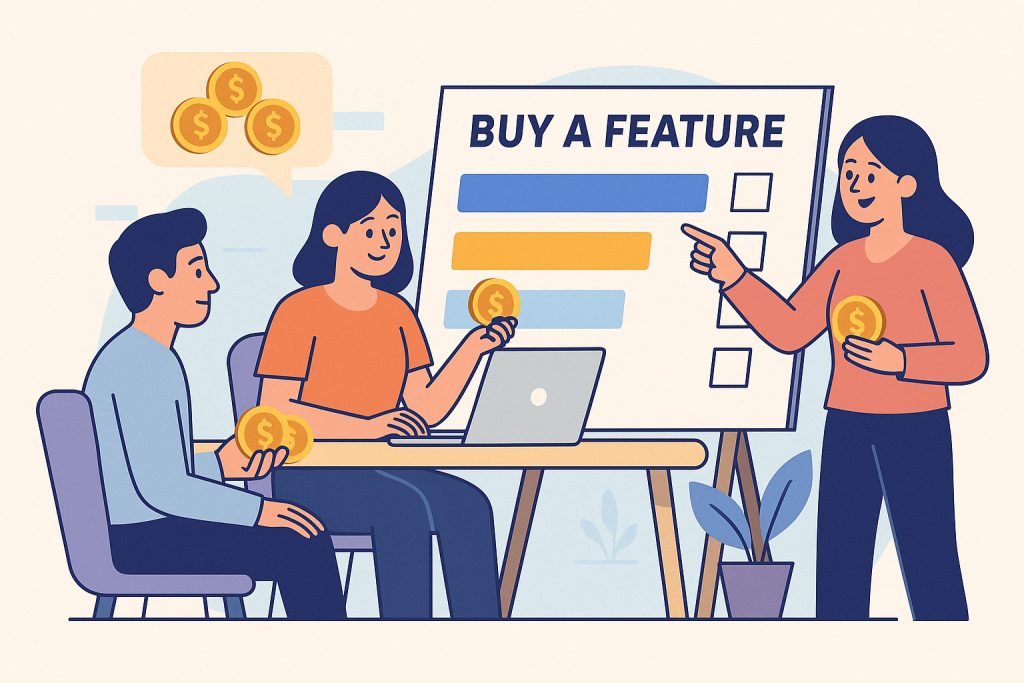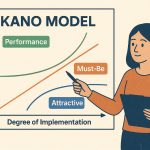Product managers constantly wrestle with the challenge of determining which features deserve development resources. Amid competing stakeholder demands, customer requests, and strategic objectives, the question “What should we build next?” becomes increasingly complex. Traditional prioritization methods often fall short, leaving teams with endless debates and little clarity on actual user preferences.
Enter Buy-a-Feature—a collaborative prioritization framework that transforms abstract decision-making into a tangible, interactive experience. Rather than relying on theoretical discussions or complex scoring matrices, this approach puts customers and stakeholders in realistic scenarios where they must make trade-offs with limited resources, revealing their genuine priorities through action rather than words.
What is the definition of Buy-a-Feature Prioritization Model?
Buy-a-Feature operates on a refreshingly simple premise: give participants a fixed budget of play money and let them purchase the features they value most from a carefully curated list of potential product enhancements. This gamified approach mirrors real-world constraints, forcing meaningful conversations about value, necessity, and trade-offs.
The framework’s strength lies in its authenticity. When faced with limited resources, people naturally reveal their true priorities. Unlike surveys where respondents can express interest in everything, Buy-a-Feature creates genuine scarcity that drives honest decision-making. Participants must weigh the appeal of expensive, ambitious features against smaller, more achievable improvements.
What makes this method particularly powerful is its collaborative nature. Rather than collecting individual preferences in isolation, the framework encourages group dynamics, negotiations, and joint investments. When participants pool resources to afford high-ticket items, the resulting conversations often reveal deeper insights about user needs and market priorities than traditional research methods could uncover.
The pricing strategy adds another layer of strategic thinking. Each feature receives a price tag typically reflecting development complexity, resource requirements, or implementation risks. This creates authentic tension between desire and feasibility, helping participants understand the real costs behind their requests.
How the Buy-a-Feature Prioritization Model Works
Successful implementation requires careful orchestration across four distinct phases, each serving a specific purpose in the overall learning experience. The process demands skilled facilitation to maximize insights while maintaining engagement and authenticity.
The initial phase involves assembling your feature list and establishing strategic pricing. This seemingly straightforward task requires considerable thought. Features should represent genuine decision points where stakeholder input will meaningfully influence product direction. Overwhelming participants with too many options defeats the purpose, so curating a manageable list of 8-15 items typically works best.
Pricing these features demands strategic consideration beyond simple development costs. Smart facilitators factor in technical complexity, market risk, resource availability, and competitive implications. The key insight from innovation game theory suggests ensuring at least one feature costs more than any single participant can afford, creating natural incentives for collaboration and compromise.
The shopping phase launches the core experience. Participants receive their budgets and begin exploring options, creating immediate engagement as abstract concepts become concrete choices. This stage requires careful observation from the product team, as real learning happens not just in final purchases but throughout the deliberation process itself.
During the negotiation phase, group dynamics take center stage. Participants begin forming alliances, debating merits, and making strategic compromises. Product managers should resist premature intervention, allowing natural conversations to unfold while staying alert for opportunities to facilitate productive discussions or unstick deadlocked debates.
The reflection phase involves structured discussion about choices made individually and collectively. This debriefing often yields the most valuable insights, as people articulate their reasoning and reveal underlying motivations behind their decisions.
When to Use Buy-a-Feature to Prioritize Issues
Buy-a-Feature proves most effective in specific organizational contexts and timing scenarios. Teams wrestling with overstuffed roadmaps and competing stakeholder demands often find this method cuts through opinion noise to reveal clearer priorities. It excels when previous research methods have yielded inconclusive results or when survey respondents claim everything is equally important.
The framework shines particularly in situations where internal teams struggle with feature prioritization. When engineering, sales, marketing, and customer success champion different initiatives, Buy-a-Feature provides a democratic, evidence-based approach to resolution. The shared experience of resource constraints helps align different functional perspectives around common priorities.
However, timing matters significantly. This method works best when teams have already conducted substantial groundwork in understanding their market and identifying potential features. It serves as a refinement tool for narrowing down well-understood options rather than a replacement for foundational user research.
Consider implementing Buy-a-Feature when facing these scenarios:
- Complex feature wish lists that exceed available development resources
- Stakeholders who resist making trade-offs in traditional planning sessions
- Survey feedback indicating customers want “everything immediately”
- Need to build consensus around product direction among diverse groups
The method also proves valuable for budget allocation discussions beyond feature development. Teams have successfully adapted the framework for prioritizing bug fixes, infrastructure improvements, and strategic initiatives where resource constraints create natural tension between competing priorities.
Several warning signs indicate when Buy-a-Feature might not be the right approach:
- Participants lack sufficient product knowledge to make informed decisions
- Features under consideration are too technical or abstract for meaningful comparison
- Organizational politics make honest collaboration unlikely
- Timeline pressures prevent proper facilitation and discussion
Coalition-building patterns during the exercise reveal important market dynamics. When participants spontaneously form groups to fund expensive features, those alliances often reflect real market segments or user personas. Features that inspire collaboration frequently represent broadly appealing capabilities, while those attracting only individual purchases might serve niche needs or represent personal preferences rather than market demands.
Language and emotional responses provide equally valuable data. Features generating passionate advocacy reveal deep customer pain points, while those discussed in purely functional terms might represent table stakes rather than differentiators. Hesitation patterns prove equally telling—features that participants consider but ultimately reject often highlight areas where value propositions need strengthening.
Negotiation dynamics themselves offer strategic insights. When participants easily compromise on certain features, it might indicate those capabilities are perceived as commodity functions. Conversely, features generating heated debate or reluctant concessions often represent areas of genuine competitive advantage where investment could create meaningful differentiation.
Post-exercise analysis should examine several key dimensions:
- Purchase patterns: Which features attracted individual versus group investments?
- Timing decisions: Did participants buy immediately or deliberate extensively?
- Compromise behaviors: What trade-offs did participants make willingly versus reluctantly?
- Collaboration triggers: Which features inspired spontaneous alliance formation?
- Emotional reactions: What language and intensity accompanied different feature discussions?
The Buy-a-Feature method represents more than just another prioritization tool—it’s a window into the authentic decision-making processes of your market. When customers and stakeholders face the same resource constraints that product teams navigate daily, their choices reveal priorities that traditional research methods often miss. The collaborative nature of the exercise creates a shared understanding of trade-offs that extends beyond immediate feature selection, fostering more realistic expectations and stronger alignment around product direction. Most importantly, it transforms abstract prioritization challenges into concrete, engaging experiences that generate actionable insights while building consensus around difficult decisions that will shape your product’s future.
Conclusion
Buy-a-Feature succeeds because it transforms the abstract challenge of prioritization into a concrete, engaging experience that generates insights while building consensus around difficult decisions. By making resource constraints tangible and collaborative, the method reveals authentic priorities while fostering stakeholder empathy for the trade-offs product teams navigate daily. The conversations, negotiations, and compromises that emerge during these sessions often prove more valuable than the final feature rankings themselves, providing product managers with deep understanding of customer motivations and market dynamics that traditional research methods struggle to capture. In an environment where product teams must move faster with greater precision, Buy-a-Feature offers a path to more informed, consensus-driven decision-making that honors both customer needs and business realities.


